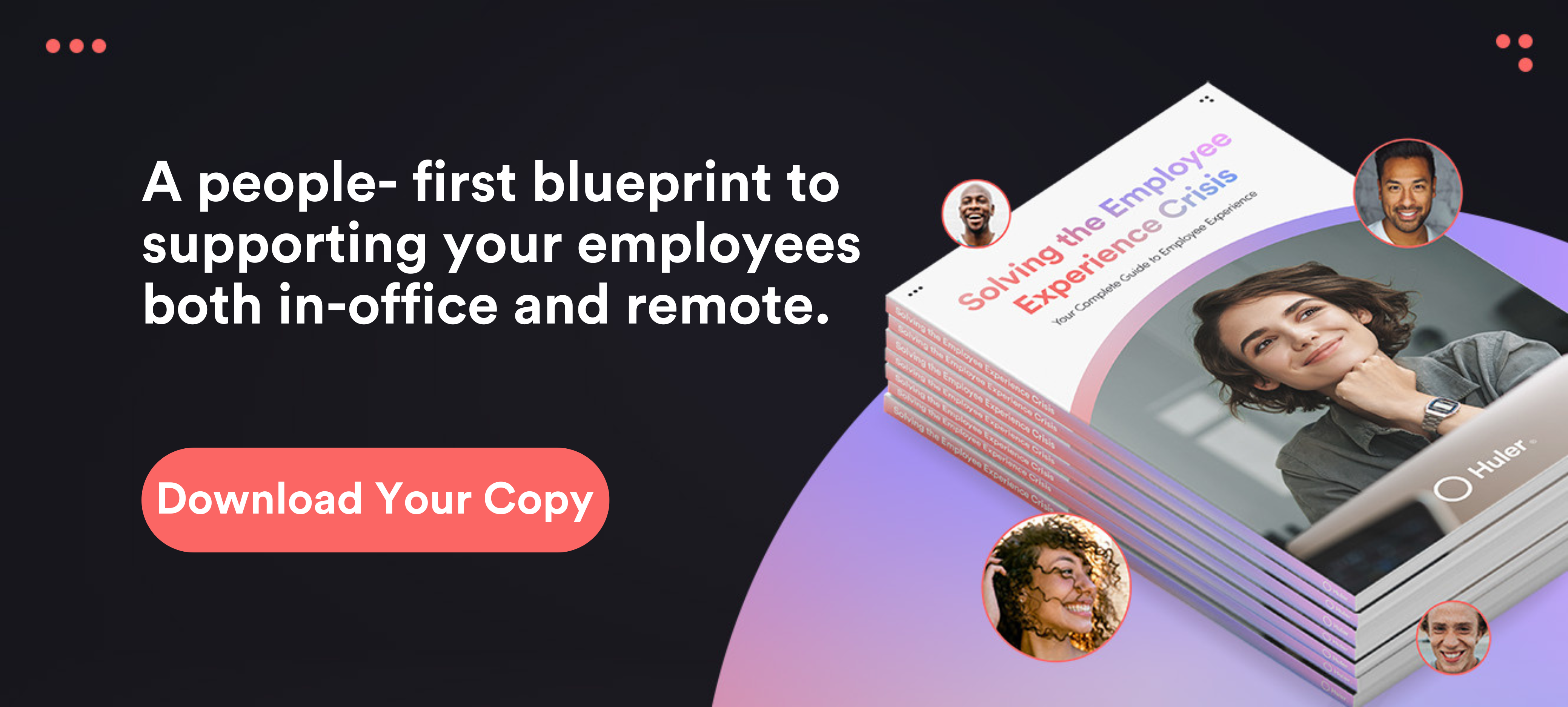Picture this. Your company makes an announcement to your employees. You make the announcement via email. Maybe it’s a change to a company policy or to let people know about an event scheduled for a certain day. But when the day comes, the policy is instigated or the event takes place, you begin receiving messages from confused employees. “I wasn’t informed…”
Every workplace needs good communication channels — from onboarding information before an employee starts, learning and development on the job, all the way through to exit interviews.
Good internal communication has recently become even more critical with the shift to hybrid working. People are no longer prepared to put up with the old methods of communication. As one study found, who wants to spend 28% of their work time reading and managing emails?¹
Companies are relying more than ever on effective and creative ways to improve internal communication. This enables information sharing across the physical and digital workspaces as employees take more control over when they work and from where. And it should be easy. Creative communication should be integrated with every part of your employees’ daily life, particularly in a remote context. Otherwise, employees might miss important information — and feel out of the loop.
This article will look at creative ways to boost your internal communications and provide strategies you can apply to your organisation today!
Use Video
Video meetings and interviews have become the norm in today’s hybrid workplace. But the use of video doesn’t need to stop there. Videos are a creative way to communicate complicated topics to your employees, provide an update or create fun content.
One study found that video content users retain approximately 95% of the content’s message, compared to just 10% when delivered by text.²
Strategies to help
- Employee-generated videos: This is a creative way to get employees to feel engaged with their work. This could include informal employee interviews or employees creating a video blog about their day. It’s especially important for remote workers’ employee experience to feel connected to their colleagues outside of meetings – this is one way to do that.
- Animated videos: Animations are a creative way to convey company statistics, information or announcements and make them more memorable. Within your digital workspace, you can apply animations or videos to notifications and announcements to make them more attractive. This makes the information more eye-catching, increasing open rates.
- Onboarding: When employees start at your company, making sure they feel welcomed and comfortable is vital. Using videos during onboarding can help create a personal touch for new starters, for example through a welcome message from the manager, a ‘meet the team’ video or virtual tour of the office. This is key to creating a supportive and people-first onboarding process.
Create a consistent culture across your physical and digital workspaces
Everyone who works in your company should feel they receive a consistent experience, whether they’re in the office, at home or working elsewhere. With more team members working remotely, this is crucial so that employees feel connected to their colleagues and part of the same community.
The digital workplace must therefore provide the same accessibility and clarity of information as the office.
Strategies to help
- A people-first digital workplace: Your digital workspace needs to be easy to navigate and customisable. Employees should be able to personalise their own workspace and easily access all of the tools, systems and content that’s relevant to them. If information is easy to find in the office, it should be just as easy in the digital workplace.
- Working across multiple devices and places: Employees should be able to pick up their work where they left off. So when they move from the office to home, the information across their digital workspace should be where they left it. This also means employees should be able to work across multiple devices, for example finishing work on a mobile that they started on a laptop.
- Brand personality: Your business has a brand and an aesthetic. Try and create a consistent personality across your physical and digital workspaces through a consistent language and look. This can help employees feel connected between all their workspaces and receive a consistent experience.
Reduce email
The average worker receives approximately 121 emails per day.³ Emails still have a place in a communication plan, but they are fast becoming inefficient and outdated. With changing work expectations, people also expect more flexible communication methods. This means businesses need new internal communication ideas.
Strategies to help
- Use notifications instead: Using a notification centre within your digital workplace platform can help streamline communication. Notifications can be used to communicate actions to specific employees or company-wide announcements. Administrators can also remove old updates or information from employees’ view, ensuring only the right information is presented.
- Employee survey and quizzes tools: Instead of delivering employee surveys and quizzes by email, you can use dedicated tools, notifying them and prompting participation through their digital workplace.
Utilise interactive content
It’s time to admit it: internal communications can often be passive and unengaging. So how can you turn a dull corporate survey or a company-wide announcement into something more engaging? One creative way is interactive content.
This is where employees are encouraged to interact with communication, for example by clicking through and writing responses rather than just reading. The content asks questions, provides choices, and explores scenarios. 66% of marketers say interactive content produces greater audience engagement than ‘static’ content.⁴ Imagine how this could help your employee experience!
Strategies to help
- Interactive emails: When you have to send an email, make it interactive. Employees can click, respond, or comment on various email features, redirecting them through to other pages. This can make company newsletters and pulse surveys more engaging, helping you get more responses.
- eLearning: Interactive content can be a very effective tool when onboarding new starters and in learning and development courses. Incorporating quizzes, videos, and guided chapter navigations creates an interactive and engaging experience that can make mandatory training more memorable.
Wherever there’s an opportunity to make internal communication more interactive, even by adding links to an email with important information, try it.
Recognise employees — publicly
Recognising employees for their effort and work is a great way to improve employee experience and engagement — and a particularly good way to keep remote employees engaged. It leads to higher morale, better company culture, higher job satisfaction, engagement, and increased motivation.⁵
Strategies to help
- Peer-to-peer recognition: Peer recognition programs are a simple way for employees to publicly recognise each other’s accomplishments. Receiving praise from peers can help with motivation and create a sense of camaraderie between colleagues.
- Use a dedicated employee recognition feature: A dedicated feature can help recognition feel more meaningful. Using ‘rewards’ or ‘points’ can help foster a sense of achievement, or simply commenting on an employee’s profile can have a motivating effect.
- Encourage social media recognition: Social media can be a powerful way to recognise employees publicly. For example, businesses can highlight employees’ accomplishments on their Linkedin or Facebook pages. A simple tweet from an executive highlighting an employee’s achievement can go a long way to make someone feel valued.
Embrace gamification
Employee recognition through rewards or points is an example of gamification at work.
Gamification uses game design aspects, such as rewards, personalisation and leaderboards, in non-game situations.
Businesses can use gamification techniques to help employees feel more engaged with their work, keep track of their progress and feel recognised.
Strategies to help
- Learning and development: By using points, scoring and bonuses in onboarding and learning and development, employees get a physical view of their progress and achievements. Badges and leaderboards are gamification elements that can increase employee participation.
- Keeping track of work: Progress bars, checklists and ‘missions’ can be incorporated into digital workspaces to help employees keep on top of their work and see their progression.
- Feedback and surveys: Gamification can make longer communication efforts, like feedback and surveys, more engaging. You can also add gamification elements to the results: for example asking employees to guess the correct answers to survey questions.
Pro tip: Gamification requires a modern digital workplace. Intranets, designed for simple administration, can be clunky and impractical.
Show your personality
One notification arrives on your screen with an emoji. Another arrives only with text. Which one are you more likely to open first?
Showing off some personality shouldn’t be considered an innovative way to communicate – but it sometimes is. You have important information to communicate but, where appropriate, this doesn’t have to be overly formal.
Strategies to help
- Keep it casual: Show personality by setting an informal tone and avoiding corporate jargon. Internal communications must address people in a relatable and engaging way. Soften corporate jargon and use informal language where you can.
- Make it memorable: Emojis, GIFs, and memes can help convey information – and make people smile.
- Tell stories: We are wired for stories. Internal communications should utilise storytelling by shifting the focus away from goals, achievements and accomplishments, and towards the people behind them. Creating a narrative around experiences and challenges can be a powerful tool to increase employee recognition, engagement and motivation.
The right tools for creative communication
The use of creative internal communication methods can be considered an investment in your business’s growth. Communicating creatively with your employees can help improve their experience and make them more engaged. And teams with low engagement see turnover rates 18% to 43% higher than engaged teams.⁶
In an age of hybrid and remote working, using creative employee communication methods helps to ensure that communication is not only seen and understood by employees — but that it’s engaging, too.
That’s where Huler comes in. HulerHub combines your internal communications, knowledge, processes, tools and insights in a streamlined and customisable employee engagement platform. By bringing together everything you need in an easy and accessible way, HulerHub empowers your team to work effectively, from anywhere. And on any device.
With hybrid working now the norm, HulerHub helps create a consistent experience across your entire workplace, both digital and physical, ensuring communication reaches everyone in clear — and creative — ways.
(Bonus: and keeps your employees’ email inboxes unclogged!)
Book a demo and try it today.
- How Much Time Do Your Employees Spend On Checking Emails?
- 5 Ways animated video boosts internal communication
- Email Usage Statistics in 2021 | Campaign Monitor
- 21 Interactive Content Stats To Boost Your Business in 2021
- SHRM/Globoforce Using Recognition and Other Workplace Efforts to Engage Employees
- The ROI of employee experience – Netigate







